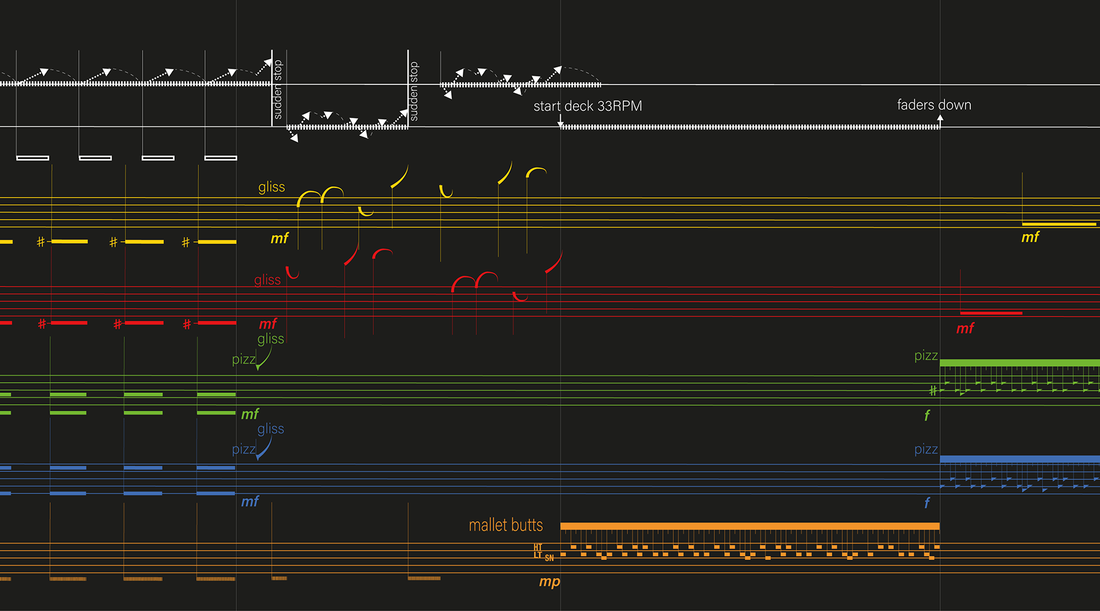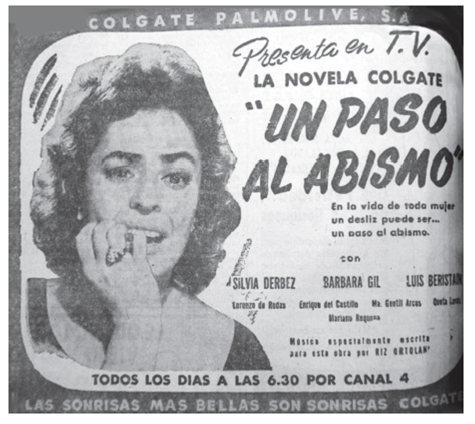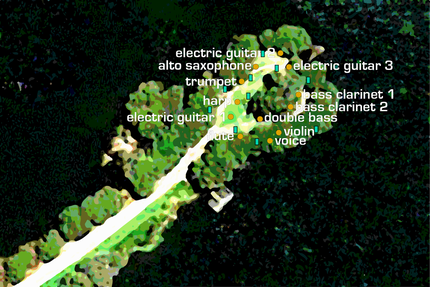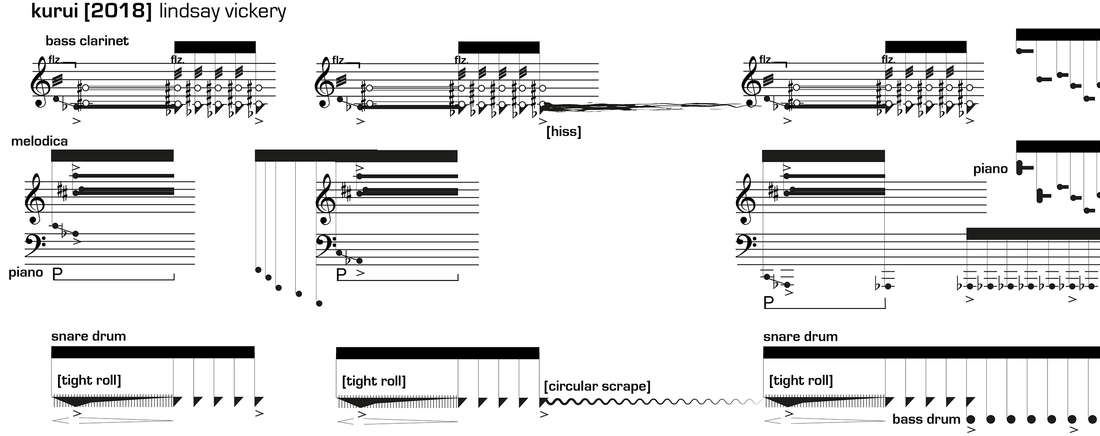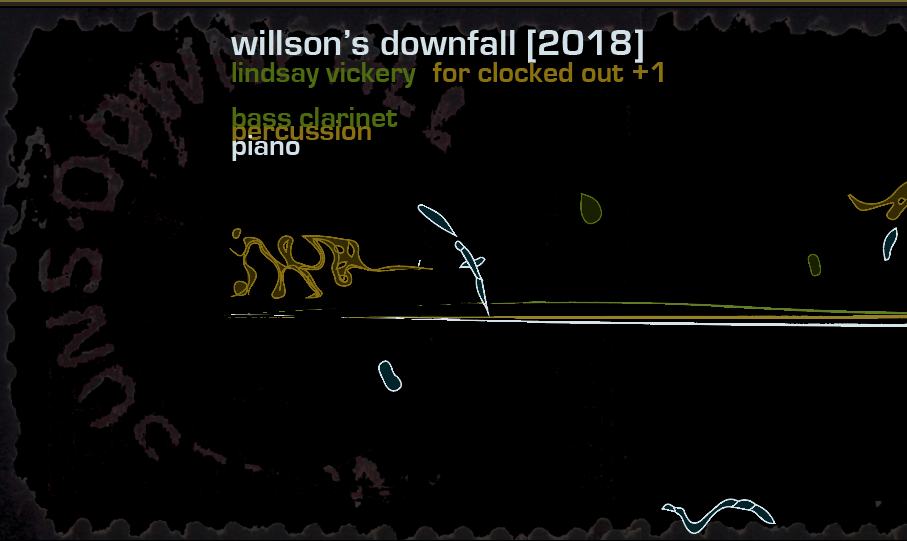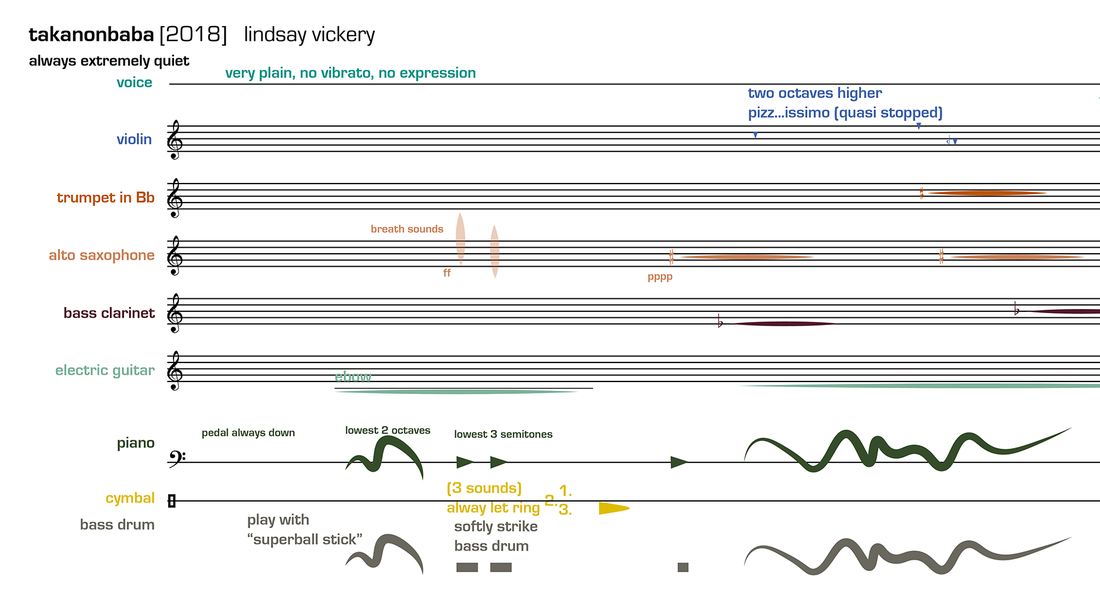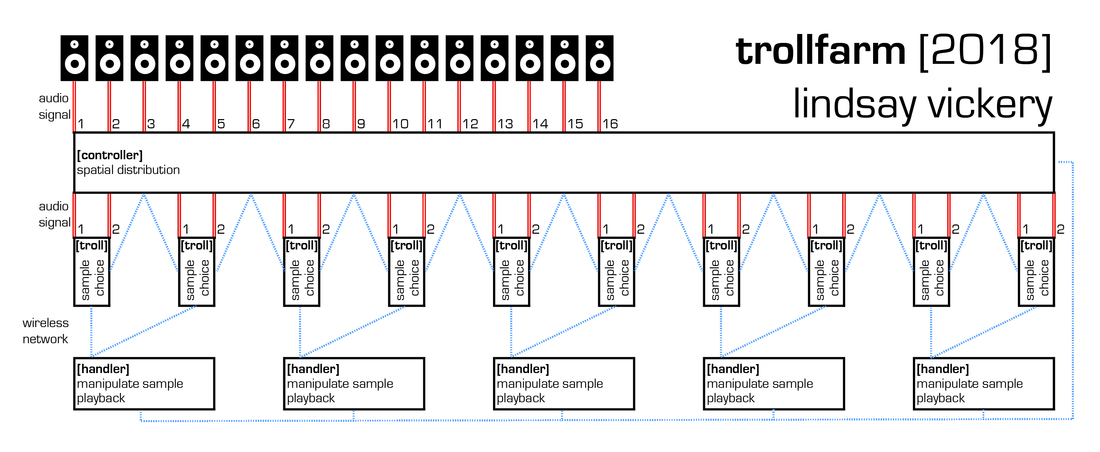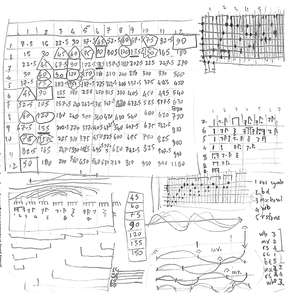2018
184 Thalweg [2018] for electric guitar and electronics
|
Performance:
20181208 Jameson Feakes - Australasian Computer Music Conference 2018, Perth Australia |
A Thalweg is a line connecting the lowest points of successive cross-sections, most commonly the lowest points in a body of water. As such it is often transformed into a symbolic and transient boundary between human-defined territories. In this work a scrolling extended notation score is presented to the performer in indeterminately selected sections. A real-time spectral analysis of the electric guitarist’s performance is used to determine parameters of audio processing including temporal and pitch shifting, spectral manipulation and threshing and down-sampling. The analysis data obtained in successive cross-sections is used to create a shifting remapping of the guitar’s output that is dependent upon the nonlinear progression of the work.
|
183 agitation techniques in a closed system [2018] for turntables, bass flute, bass clarinet, viola, cello and percussion.
|
agitation techniques in a closed system intertwines blocks of sonic material exploring a range of situations and relationships between turntables, acoustic instruments and a mini-jack (a fantastically versatile musical instrument). A sort of uneasy tension is maintained by using Vinyl’s predominant speeds 45 and 33 1/3 RPM to define the work’s rhythmic and structural proportions. The title actually comes from a medical article about wound care, that caught my eye in the context of a book I was reading Theo Deutinger’s Handbook of Tyranny. The book details protest crowd control and many other social issues that press on our minds in these times. The LPs themselves come from the remains of my collection - (Martinu, Stockhausen, Scriabin, Hindemith, Tavener, Marta, Milhaud and Elgar) - that is kindly housed by Robert Muir, and a set of “tuning” records left in my office by Petro Vouris.
Performance:
20220628 Decibel, Revolution, Melbourne Recital Centre 20181203 Decibel, Revolution, Subiaco Arts Centre |
|
182 telescope turbine [2018] with Camilla Hannan for flute, clarinet, electric guitar, harp, cello and mechanical recording
|
Performance:
20181114 7:30pm Wed 14 Nov - GreyWing Ensemble Old Custom’s House, Fremantle |
Camilla Hannan’s recordings for this work are from a radiotelescope located at the Mt Pleasant Radio Observatory outside Hobart in Tasmania. The sound is of the gigantic telescope dish moving towards another celestial destination. The other main sounds are from a wind turbine, also located in Tasmania. Lindsay Vickery analysed and annotated the recording to create a score for GreyWing exploring its contour and grain with acoustic instruments.
www.camillahannan.com |
181 Un Paso al Abismo [2018] for 11 live soap-opera feeds and drummer.
|
in 1951 a Mexican engineer invented an electronic earpiece for instant communication with actors that became a standard and somewhat unique element of the Televisa production process. Performers could be fed their lines, either between takes or while taping was in process; as a result, the speed of recording was greatly enhanced
Paxman, A. (2003). Hybridized, Glocalized and hecho en México: Foreign Influences on Mexican TV Programming Since the 1950s. Global Media Journal, 2(2). |
|
Un Paso al Abismo (One step from the Abyss) is the title of one of the earliest Mexican Telenovelas. Its name is evoked here because of the process for delivering the score: conveying the sounds directly to the performers via headphones for them to realise instantaneously as they heard. This technique was developed in Mexico by Televisa in 1951 to the reduce the recording time for Telenovelas such as Un Paso. The sounds in this case are excerpts of dialogue from the long-running (over 13436 episodes) US soap opera Days of Our Lives (1965-). During a stay in Holland I watched Dagen van ons Leven more or less every day for several weeks and these excepts focus on a plot lines from that time: the secret of Aremid, the machinations of Stefano Dimera, Sami, Austin and Carrie’s love triangle, various new fathers assigned to various children, Tony’s double, long-lost brothers and of course Marlena and Celeste’s possession by the forces of evil. Oddly this is an idea that I apparently had around that time, then again “for the first time” about ten years later, and finally brought to fruition about ten years after that.
20181012 730 SHOCKOFTHENEW, Spectrum Project Space (stefano - Callum O'Reily, marlena/celeste - Annika Moses, lexi kirsten Symczycz, abe/repairman - Dan O'Connor, gran - Lindsay Vickery, john - Stuart Orchard, sami- Shoshana Rosenberg, austin - Elliot Peacock, carrie - Cissi Tsang, tony - rodrigo kendrick, dr steve - pippin kenworthy and drums - Josten Myburgh)
|
|
180 rising water [2018] for bass clarinet, electric guitar, harp and artificial field recording.
The complex physical sounds of nature - wind, fire, water - are perhaps the most difficult to render within a human “musical” framework. In particular, the problem of representing the sound of water has been a ongoing preoccupation of mine. rising water explores this problem through a series of depictions of water via a field recording made by Leah Barclay of flood waters in Queensland. The recording was resynthesised: firstly by using frequency data to control amplitude and amplitude date to control frequency; secondly by "threshing" - using and sustaining only the strongest frequencies; and finally by "freezing" the frequency spectrum at points of prominent volume transitions. The spectral freeze points were then used to derive a sectional formal structure for the work. This score was created by separating spectral data into three colours (timbres) to generate parts for the three instruments. Material from the three resynthesis techniques were used to define the sectional structure. The result is not the solution to the intial problem, but perhaps an interesting step in that direction.
Based, with thanks, on a field recording of Leah Barclay
Based, with thanks, on a field recording of Leah Barclay
|
Performance
20180909 GreyWing - Artificial Field, Cool Change Gallery, Perth |
|
179 njookenbooro [2018] for violin, flute, trumpet, alto saxophone, 2 bass clarinets, 2 voices, 3 electric guitars, harp, double bass and bluetooth speakers.
|
|
njookenbooro was written for the Limited Hangout: in the field series of site specific performances. The site of the performance was a walkway jutting into Njookenbooro (Herdsman Lake) in Perth. The score was created through transcriptions of prominent environmental frequencies and the contours of bird and frog sounds recorded at the location.
Performance
20180902 Herdsmans Lake Limited Hangout: in the field 2 Performed by catherine ashley - harp, jameson feakes - electric guitar, pippin kenworthy - electric guitar, annika moses - voice, josten myburgh - alto saxophone, dan o'connor -trumpet, shoshana rosenberg - clarinet, kirsten smith - piccolo, cissi tsang - electric guitar, lindsay vickery - bass clarinet and phillip waldron - double bass.
|
delicious ironies 4 [2018]
Delicious Ironies was created as a vehicle to provide an extremely unpredictable and provocative sonic environment for the solo improviser. The intention was to use sound samples that were pertinent to the soloist, but also volatile and erratic enough to inspire an interesting improvised response in the moment. This version was created specifically for Clocked Out in 2001 using samples of Sichuan Opera percussion instruments (and percussionists) made by Erik Griswold during one of the duo’s early visits to the province. Their contact with Sichuan has since become a major theme and influence and we thought it would be interesting to return to this work – but update it a little.
|
Performance
20180824 Griffith Conservatorium, Brisbane, Clocked Out and Lindsay Vickery. |
178 kurui [2018] for bass clarinet, melodica/piano and percussionKurui was composed for Clocked Out and a performance at the Cooroora Institute. The institute’s name is derived from the Gubi Gubi language name for possum: kurui. This is a piece created from trascriptions of possum sounds – which as probably every Queenslander knows – can be pretty odd. In between the transcriptions are some (potentially equally odd) human sounds – not in the possum’s repertoire but hopefully with a bit of their attitude.
|
blog post 27 Aug 2018
Performances
20180824 Griffith Conservatorium, Brisbane, Clocked Out and Lindsay Vickery. 20180825 Harrigan's Lane, New South Wales, Clocked Out and Lindsay Vickery. 20180826 Cooroora Insitute, Queensland, Clocked Out and Lindsay Vickery. |
177 willson's downfall [2018] for bass clarinet, piano, percussion and willson's downfall (or a recording of willson's downfall)
|
The score for willsons downfall [2018] was written for a performance at Harrigan's Lane a property in the Great Dividing Range on the border of New South Wales and Queensland. The performance was part of my sub-residency within a residency by Clocked Out (Erik Griswold and Vanessa Tomlinson) at the Griffith Conservatorium in Brisbane. The work continues a line of exploration of site-specific work responding to environments, field recordings and landscapes.
blog post 27 Aug 2018
Performances
20180825 Harrigan's Lane, New South Wales, Clocked Out and Lindsay Vickery. |
176 takadanobaba [2018] for voice, violin, trumpet, alto saxophone, bass clarinet, electric guitar, prepared piano, percussion and fixed media .
|
Performances
20180511 Members of Tone List Collective, Spectrum Project Space, Perth 20181016 UTAS Eyjafjallajökull - Experimental Music Ensemble, Hobart. 20181208 Tone List Collective - Australasian Computer Music Conference 2018, Perth Australia |
Like most Tokyo metro stations, Takadanobaba is filled with the very noisy and chaotic sounds of humanity. Sometimes such places seem paradoxically empty and almost still. In this work a field recording of the station underwent an analogous stripping of sound - removing all but the most prominent frequencies and then stretched to nearly ten times its original length. The resulting "empty" recording was annotated and orchestrated for an ensemble of 8 performers. The synchronised networked scrolling score composing a range of extended instrumental techniques is presented to the performers in conjunction with a remixed recording of the source audio. The work extends my exploration of an “Ecostructural” approach into an entirely anthropogenic environment. The sonic structure of the work is derived from the sounds of the station albeit more slowly. It was written for and is dedicated to performers from the Tone List group.
|
174 sanctuary [2018] for percussion quartetThe fifth in a series of polytempo experiments that includes whorl, particle+wave, zwitschern and flitter. Four percussionist perform independent notation and click-track scores on iPad. The click-tracks change speed in proportionally related waves and plateaus.
Louise Devenish, Jackson Vickery, Ben Greene, Claire Orman - percussion
Performances
20180325 GreyWing - nature forms I Album Launch - Eric Singleton Bird Sanctuary, Bayswater |


